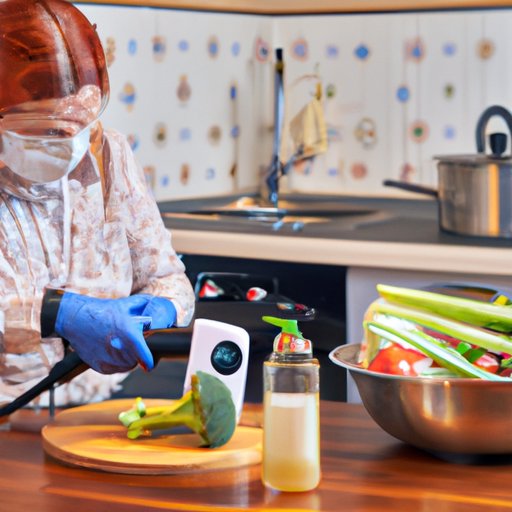
Introduction
When it comes to food safety, preventing physical contamination is just as important as avoiding chemical and biological contamination. Physical contamination refers to the presence of any foreign object in food that can cause harm to consumers. The risks of physical contamination in food cannot be overstated, as they can cause severe injury or illness. In this article, we will explore what physical contamination is, its sources, risks and dangers, types of contaminants, prevention methods, and common examples to avoid.
Uncovering the Risks: Identifying Physical Contamination in Food
Physical contamination happens when a foreign object gets into food during the production, preparation, packaging, or transportation process. It can come from a wide range of sources such as raw materials, human handling, machinery, packaging material, and the environment. Some of the common sources of physical contamination include hair, jewelry, glass, metal shavings, plastic fragments, and insects.
The dangers of physical contamination in food cannot be ignored, as they can cause harm to individuals who consume the contaminated food. These objects can damage the teeth, puncture the digestive system, and pose a choking hazard. In severe cases, they can lead to surgical emergencies, infections, or even death. As such, the prevention of physical contamination is essential in ensuring food safety.
The Invisible Danger: Understanding Physical Contaminants in our Food Supply
Physical contaminants come in various forms and sizes, which can make it difficult to detect them with the naked eye. Some examples of physical contaminants include:
– Glass: broken shards of glass from packaging or light bulbs.
– Metal: metal shavings from machinery, parts of equipment, or metal staples used in packaging.
– Plastics: fragments of plastic packaging materials or utensils used during the food production or preparation process.
– Bones: small bone fragments that can break off during processing of meat or fish products.
– Stones: small stones that can be found in vegetables, nuts, or other food products.
Each type of physical contaminant can cause different harm levels to an individual’s health. Ingestion of glass, metal, and plastic can lead to serious injuries, while bones and stones can cause choking or other digestive tract injuries. The sources of physical contaminants vary, but they can usually arise during the production, processing, packaging, and transportation of food.
A Closer Look at Physical Contamination: Types and Prevention Methods
Prevention methods are the key to avoiding physical contamination in the manufacturing and preparation of food products. Here are some of the types of physical contaminants and the corresponding prevention methods:
– Glass: Packaging materials must be break-proof and food packaging lines should have an inspection system to detect broken glass.
– Metal: Proper maintenance of the equipment should be conducted to prevent metal shavings and parts from falling into food. In addition, metal detectors can be used to find the presence of metals in the product.
– Plastics: Food packaging material should be designed to prevent fragments from chipping off, and the use of plastic utensils should be discouraged.
– Bones: Meat and fish products should be handled carefully and undergo thorough inspection and deboning before processing.
– Stones: Appropriate cleaning and sorting of vegetables, nuts and fruits should be conducted to eliminate the presence of stones.
Prevention methods must be implemented in every step of the production line, packaging, and transportation processes to avoid physical contamination of food products.
The Impact of Physical Contamination in Food: An Overview
Physical contamination in food can have negative health, economic, and legal consequences. The negative health effects range from mild to severe harm that can lead to hospitalization or worse. When it comes to the food industry, physical contamination can lead to recalled products, which can lead to lost revenue or damage to the company’s reputation. Monetary fines can also be levied against the company in cases of physical contamination. The legal issues of physical contamination can also be a significant burden for individuals and businesses.

Detecting and Eliminating Physical Contamination in Your Kitchen
Physical contamination can happen even in your own kitchen, so it is essential to detect and eliminate them to prevent harm to you and your family. Here are some guidelines to detect physical contamination:
– Thoroughly inspect raw materials, such as fruits, vegetables, and meat products before washing or cooking them.
– Check expiration dates on packaged food products before consumption.
– Use clean and well-maintained utensils during food preparation and ensure fragments of utensils are not left in the food.
– Washing hands before handling food products.
Here are some measures that can be taken to eliminate physical contamination:
– Straining sauces or soups to remove any small bone fragments, stones or other contaminants.
– Cutting off the contaminated part of a food product, such as a bruised apple or a moldy bread corner.
– Use of appropriate containers for storage of food products.
5 Common Examples of Physical Contamination in Food and How to Avoid Them
Here are five common examples of physical contamination in food and some actionable practices to avoid them:
1. Hairs – Wear hairnets or caps to prevent hair falling into food during preparation or cooking. Inspect food before ingestion.
2. Insects – Store dry foods in sealed containers, keep areas clean.
3. Metal shavings – Prevent ingress through the use of well-maintained machinery and switching to metal-free options where possible.
4. Glass – Use unbreakable and shatter-proof packaging materials. Inspect food before ingestion.
5. Plastic Fragments – Use high-quality food packaging materials designed to prevent fragmentation.
By maintaining proper hygiene in your kitchen, purchasing food products from reputable sources and applying the preventive measures described above, you can mitigate the risk of physical contamination and protect your health.
What Is Physical Contamination and Why Is It a Concern for Food Safety?
In summary, physical contamination is a serious concern for food safety that can lead to severe illnesses, injuries, and legal and economic consequences. It occurs when foreign objects enter food during production, preparation, packaging, or transportation. The types of physical contaminants include glass, metal, plastic, bones, and stones. Prevention methods such as proper equipment maintenance, inspection, and sorting processes can reduce physical contamination risks. It is essential to be vigilant about detecting physical contamination in food products and taking the necessary measures to eliminate them.
Conclusion
Preventing physical contamination in food is an essential aspect of food safety as it can cause severe injury or illness. By being aware of the sources, risks, types, and prevention methods of physical contamination, individuals can take appropriate measures to avoid it. The elimination of physical contamination from food is critical to the food industry in maintaining consumers’ trust and, most importantly, ensuring public health safety.





